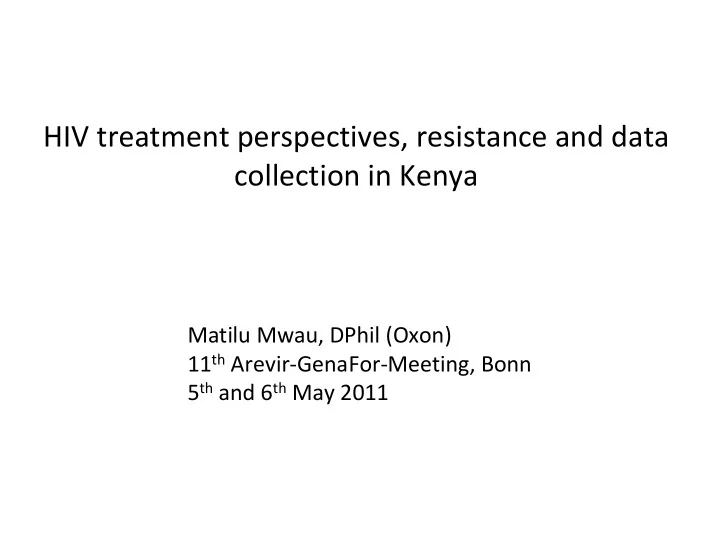

HIV treatment perspectives, resistance and data collection in Kenya Matilu Mwau, DPhil (Oxon) 11 th Arevir ‐ GenaFor ‐ Meeting, Bonn 5 th and 6 th May 2011
Kenya AIDS Indicator Survey 2007: 20,000 aged 15 ‐ 64 were tested 7.4% of these were HIV ‐ positive 1.4 m adults HIV+. f 8.7%, m5.6%. Young women aged between 15 ‐ 34 disproportionately infected
Key Adult regimens in use in Kenya (2010) Option 1: d4T/3TC/NVP 172348 (54%) Option 2: d4T/3TC/EFV 35685 (11%) Option 3: AZT/3TC/NVP 54236 (17%) Option 4: AZT/3TC/EFV 28428 (9%) 2nd Line regimens: 10097 (3%) Others: 18864 (6%) Total: 319658 (100%)
Pediatric regimens in use in Kenya Option 1: d4T/3TC/NVP 6571 (23%) Option 2: d4T/3TC/EFV 2438 (9%) Option 3: AZT/3TC/NVP 9824 (35%) Option 4: AZT/3TC/EFV 3839 (14%) 2nd Line regimens: 832 (3%) Other regimens: 4901 (17%) Total: 28405 (100%)
ART regimen changes in the MSF ‐ S Busia cohort Reasons for changing ART in the MSF Cohort 9.2% ‐ started TB Rx 8.1% had lipodsystrophy 4.2% had peripheral neuropathy 3.13% finished TB medications 0.8% had a rash due to NVP Virologic Immunological Clinical Failure failure failure Regimen change 1 Ye No Yes No Yes No s FDC1 (D4T30-3TC-NVP) OR 2 28 4 26 4 26 FDC2 (D4T40-3TC-NVP) FDC7 (AZT-3TC)+NVP 6 113 16 103 9 110 EFV600+FDC5 (D4T30-3TC) OR 8 88 53 45 12 86 EFV600+FDC6 (D4T40-3TC) EFV600+FDC7 (AZT-3TC . 1 . 1 . 1 total 16 230 73 175 25 223
Institutions in Kenya conduct small scale HIV DR research 1. K. Steegen et al. , AIDS Res Ther 6 , 12 (2009). Drug resistance mutations are a very major concern at CPGH K103N, M184V, Q151M, K65R. 2.M. Kiptoo et al. , AIDS Res Hum Retroviruses 24 , 1555 (Dec, 2008). 27.%% of mothers had resistant viruses 3.R. Lwembe et al. , AIDS Res Hum Retroviruses 25 , 141 (Feb, 2009). 33.3% of orphans had resistant viruses before treatment; 58% after Rx 5.The PASER Study 5% have (mostly single class) resistance 6.NASCOP/CDC Studies HIV DR was less than 5% before 2008.
Kenya’s HIV Drug resistance country plan Kenya adopted the WHO plan, launched in 2008 The country plan has three key objectives: Monitoring Early Warning Indicators Threshold surveillance of transmitted HIV DR Monitoring Surveillance of those starting Rx
Collection of Early Warning Indicators (2009) Aims: To collect and analyse EWIs from representative ART sites To assess the extent to which ART programs are functioning. To use the findings to strengthen ART practices in Kenya Integrate EWI collection into national ART program activities.
Collection of Early Warning Indicators, 2008
Ongoing: 1. Threshold survey of transmitted HIV DR 2. Monitoring surveillance
Integrated Information Technology And Human Resource Capacity Building For HIV Drug Resistance Surveillance And Management Project Objectives: a.To improve expertise and GCP for surveillance and Mx of DR b.To upgrade on ‐ site IT infrastructure and to improve IT data management. c.To improve the capacity to conduct clinical trials d.To determine the incidence of HIV drug resistance in HIV+ pregnant women e.To predict treatment that minimizes mother to child transmission of HIV Methods: a.Training b.Maintaining a maternal cohort c.Use of tools: Euresist, Infcare tools
Progress report IRB Approval 3 rd March 2011 Training on sample collection and processing February 2011 Site identification: Kivuli Centre, April 2011 Data and sample collection, preparation: May 2011 onwards
Dramatis Personae
Recommend
More recommend